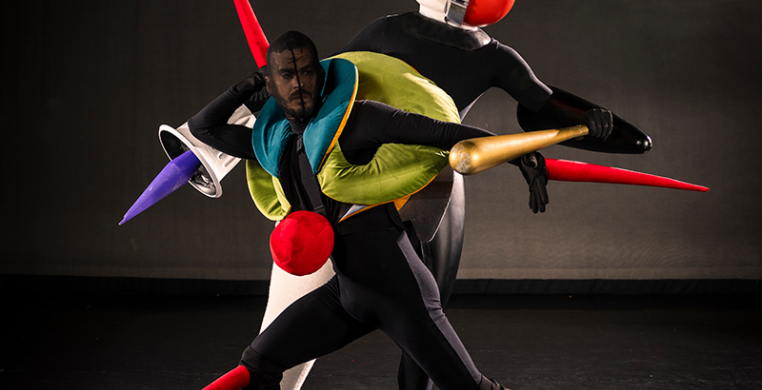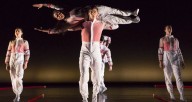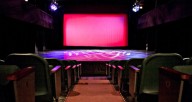It has been one hundred years since the debut of the surreal Triadic Ballet (Triadisches Ballett) that premiered in Stuttgard in 1922. A work in the Bauhaus style, its colorful automatons, built of oblong shapes, dance nimbly around a colorful void. Hedwig Dances and Bauhaus Dessau have co-produced an official sequel that is every bit as imaginative and “out there” as the original.
Before the eponymous main event, there is a premiere, titled Syzygy, by Mike Tyus, an LA-based choreographer who is no stranger to Chicago, having recently worked with such companies as The Joffrey School, Chicago Repertory Ballet and Visceral Dance Chicago.
What would it look like if a waterfall could take human form and cascade about a stage? Well, this is it! A trio—Rigo Saura, H. Meneses and Paula Sousa—trickle like streams along three separate paths of light. Then, the floodgates are let loose! A robotic voice utters a long “whooooaaahhhh” as the streams combine. One dancer stands atop another while the third steadies them both, then they swap levels, constantly shifting into different variations, like oil dancing around molecules of water. Beneath projected inkblot patterns of light, the trio becomes the wandering waterfall, intertwining streams forming a deluge of twisting limbs and cresting lifts. In Syzygy, Tyus again proves that they are adapt at focusing on a theme like continuous movement and developing it thoroughly, planting imaginative thoughts in the mind with creative visual effects for the eye.
Founder and Artistic Director of Hedwig Dances, Jan Bartoszek, choreographed META MOR PHOS (A Triadic Fiction) in collaboration with dramaturg and research associate of Bauhaus Dessau, Torsten Blume. The result is ((OMIT:a)) faithfulness to Schlemmer’s original version. Although the work had its international premiere last September at the Bauhaus Museum, these April performances at the Ruth Page Center for the Arts will mark the U.S. premiere.
In META MOR PHOS, dancers lumber and glide around in humongous costumes made of cubes, spheres and various triangular shapes that gleam with bold primary colors of red, blue and yellow. The soundtrack by Patricia Taxxon is an appropriate composition containing waves of synthetic tones, cooky bleeps and bloops and thunderous dissonant static.
The work pushes the imagination to conjure events on a macro and micro scale. These are not humans that take the stage, but celestial beings, waging cosmic battle in the black void of space. Two attendants with heads like giant pills and red spheres for hands announce an imperial alien guard. The guard thrusts forth a head that is half red sphere and half a giant eyeball and aims their lance for an arm threateningly in the direction of the audience—it’s an invasion! More benignant forces join the battle, and, in a twist, all combine their parts to form a new, young god with the ability to fly by sheer willpower (i.e. two dancers dressed in head to toe black that carry the being in elliptical patterns). Despite the bulkiness of the costumes, the dancers move with a grace and ease that make the characters’ personalities endearing.
From there, the story is more down to earth-ish. Sensing the power of this new god, an ancient force in the shape of an eight-foot-tall tower with multiple swinging sticks attached around its saucer-like head, emerges and attacks. It’s stick-limbs spin wildly, driving the new god away. Triumphant, the old god rests on a nearby planetoid, but, as soon as their back is turned, the native lifeforms—gloopy, globby, boulder-size amoebas and insect-like humanoids—begin to evolve into a new species that looks up to the stars, the beginning of a new race that shall one day join those who live above all. By the end, you really feel like an explorer having traveled to the depths of space and down to the microbial plane of an alien planet.
META MOR PHOS succeeds in exuding that same quality of wonder as Schlemmer’s Triadic Ballet, drawing the viewer in and completely absorbing the imagination. This sequel keeps familiar characters from the original—the corkscrew-skirt ballerina, dragoons like colorful versions of the “Michelin Man,” the multi-armed tower being, a floating embodiment of the moon in a flat white tutu. This adds a spin on the original. Were they robots or gods, or were they first robots who became gods, or…
The fact that Bartoszek’s new work shares a continuity with Schlemmer’s classic gives us a chance to reconsider the latter and breathe new life into an old favorite.
The shapes. The colors. The athleticism. The fun!
In Tyus’ Syzygy and Bartoszek’s META MOR PHOS the audience is given several dozen imaginative prompts, clever suggestions of how to look at reality from a different angle and a new perspective. By collaborating with Bauhaus Dessau, Hedwig Dances goes back to the source, and it is this commitment to artistic integrity that makes this program truly out of this world.



